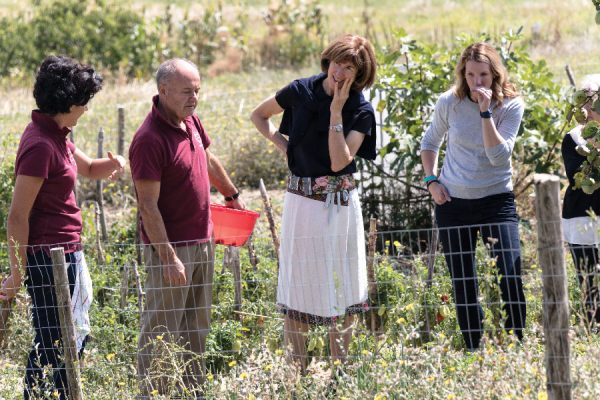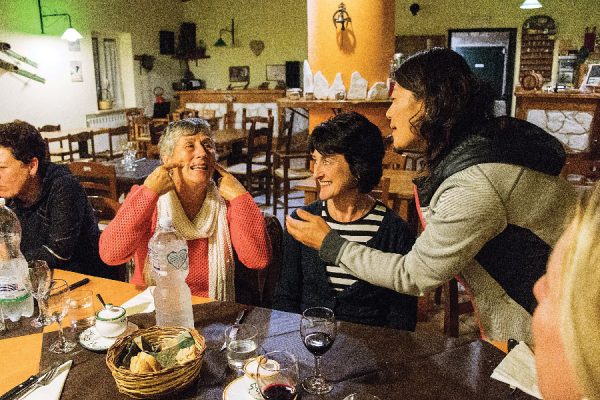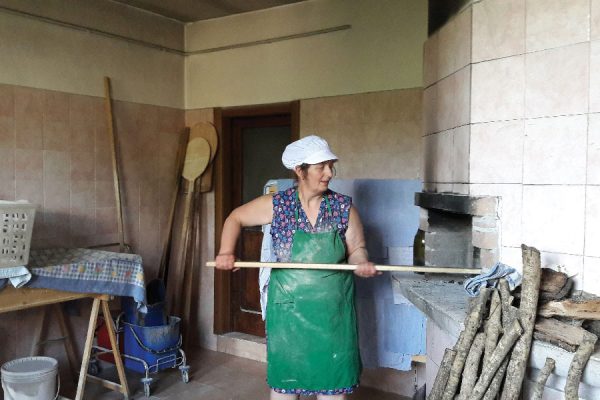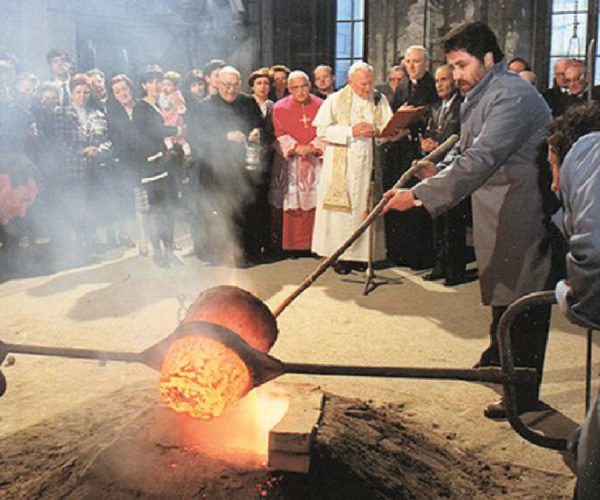Karen Jensen-Jones jumps into life in Agnone in the heart of Molise to brush up on her Italian language skills and experience a slice of authentic Italian life.

In Maria and Giuseppe’s rustic garden in the ancient hilltop town of Agnone, homemade digestivo di clementino and delicious sour cherry torta were generously offered to our chatty group of language enthusiasts, delighted by the impromptu invitation.
As the sun set over the hills, we were warmly greeted by our kind hosts; our animated conversation became louder and more confident, and our week of immersive Italian lessons began in the most delightful way.
‘Live and Learn Italian in Agnone’, founded and led by Jenifer Landor, whose family originates from this little-known town in the Molise region, is a language course offering so much more than the rules of grammar, verbs and prepositions – it’s all about a unique, local experience.
“I have a deep and profound connection to the language and culture in Agnone which comes from my Italian heritage,” explains Jenifer, whose business was inspired by her own experience of learning Italian in the town.
“My grandfather’s cousin owns the local Marinelli Bell Foundry and I’m always bumping into distant Marinellis, some whom I’ve never even met before, when I’m out and about. I love to welcome anyone who wishes to improve their Italian whilst exploring a traditional community that’s completely off the beaten track.”
BREAKFAST TABLE
Italian conversation began at the breakfast table in our pretty, four-storey B&B. Here Tonina, who grew up in the house, welcomed us every morning and shared stories of life in Agnone.
Along with stove-top coffee – freshly made in her aged moka pot – she provided a thoughtfully prepared Italian breakfast of local breads and cheeses (definitely try the focaccia), homemade cherry and peach jams (equally delicious), sun-ripened tomatoes drizzled in olive oil and completely irresistible pastries as she happily answered our questions and unravelled a few clumsy pronunciations.
Then we were off to morning class in a light-filled former convent with our enthusiastic and patient native-speaking teachers, who focused our learning and anchored the basics. Our lively group of eight was split into two groups, depending on our individual levels – a consideration taken seriously by Jenifer well before we had arrived.
LIKE-MINDED PEOPLE
“It’s very important to have like-minded people on the course who want to practise daily and really improve their language skills,” explains Jenifer.
“There are very few English speakers in Agnone so students really get to jump in and speak in Italian straight away. The Agnonesi love that you’re trying, and nobody minds if you use the wrong tense, mix up words or fluff a pronunciation; they all want to help and encourage.
“I’ve selected my teachers very carefully for their language skills and passion for Italy and they all come back to teach every year.”

Jenifer’s careful assessment of students before they arrive results in cohesive groups studying at the same pace and level for their ability. “It’s important that nobody’s out of their depth but, equally, that they’re not bored, so it’s a careful process and everybody gets to practise and improve.”
Our itinerary of tours and visits with local guides is where Jenifer’s local connections come into their own.
A sunset walk through the fauna and flora with eco farmer Marco was a fascinating study of the many uses for the hilltop plants and herbs. As the sun dipped, we enjoyed a rambling picnic of local produce with jugs of wine in a convivial atmosphere, learning new words to add to our vocabulary.
The area also boasts an ancient amphitheatre in neighbouring Pietrabbondante, a joy to explore without the usual push and shove of a major tourist attraction.
Our knowledgeable guide, local archaeologist Alessandra, explained the history of the region with tales of local Samnite battles against the powerful Romans while we enjoyed the peaceful ruins of this extraordinary arena all to ourselves.
EXPECT THE UNEXPECTED
Another unexpected highlight was a morning at the Marinelli Bell Foundry, one of Italy’s oldest family businesses, established in the 14th century.
The creation of a large bell takes three months and requires years of experience and technical skill.
Jenifer’s ancestors and the Marinelli name are well-known and important in the region and the bells are still ringing out in Agnone’s fourteen glorious churches.
On an early evening guided walk around the historic centre, we counted a dozen churches, a very short distance from each other, as we became well versed in the Venetian history of Agnone with our guide Silvana. Jenifer was often present on our trips, lending her local knowledge, as were locals Marco, Alessandro and Eulalia, offering their invaluable experiences and encouraging our conversation.
“It’s really important to tell the stories of the people of the town rather than reciting a history lesson,” Jenifer says.
“I’m always looking for the human connection as I think it helps with remembering words and phrases, and everybody enjoys the gossipy nature of Silvana’s stories and her infectious humour.”
ARTISANAL PRODUCTS

Along with the impressive classical history of the area, the region also boasts a rich heritage of artisanal products including olive oil, honey, cheese, salami, truffles and wine.
An early morning visit to a family-run smallholding to sample freshly made bread, morning buns and a selection of hand-made cheeses was a particular highlight.
Baking daily from 3am in her small wood-burning oven, baker Mercedes grows ancient grains to make her stone-ground flour, producing loaves with a texture and flavour that’s hard to beat. Warm buns, fresh from the oven, slathered in honey are well worth getting up early for and need little in the way of language translation.
Further up the hill, her son was expertly crafting goat’s cheese using traditional methods, and local cheese-maker Donato demonstrated stretching curds by hand to make scamorza, a mild cheese made into gourd-shaped balls, and bocconcini, small, rindless mozzarella cheese balls.
Samples are generous – and tasty – and we arrived back at class with yet another raft of useful Italian vocabulary and very full bellies.
HELPFUL AND WILLING
Despite the busy itinerary, the pace of the week felt just right, with plenty of pitstops for espresso and gelato and individual opportunities for conversation in and out of the classroom.
Our teachers were always helpful and willing and seemed genuinely pleased by our daily progress. Every student was catered for and Jenifer was a thoughtful and attentive host.
Food shopping – the Italian way – was fun in the lively tree-lined centre of Agnone, and armed with bags of zucchine e pomodori, olio d’oliva and basilico e mozzarella we spent an entertaining evening of pasta-making and cooking with Carlo (a cheese-maker by trade) in his homely kitchen.
Spaghetti alla chitarra and zucchine parmigiana were a triumph as we enjoyed another evening of new words and phrases, spirited conversation and perfectly al dente pasta.
Without exception, we all agreed that our listening and speaking skills had greatly improved, along with our rules of grammar, verbs and prepositions.
Immersing ourselves in the culture of Agnone and in the lives of our new-found friends had been so much more than honing our language skills – it was about the warm hospitality and good humour at the heart of this traditional community.
THE BELL FOUNDRY

THE MARINELLI BELL FOUNDRY AND BELL MUSEUM Via Felice D’Onofrio, 14, Agnone, Molise.
The tradition of smelting and moulding metals in Agnone is 2,500 years old. The Marinelli family proudly boasts eight centuries of unceasing activity at their busy foundry, which is the oldest working bell workshop in the world.
Following a fire in 1950, the foundry relocated from the old city centre to the site of an ancient former granary. This is where the master founders continue to repeat the old traditions of their ancestors, making bells for all over the world.
Our visit was fascinating, with an informative video showing the complex creation of a large bell, which can take up to three months to complete and requires years of experience and technical skill.
What a sight to witness various popes over the years blessing the newly born bells as though they were babies. This ancient craft has been passed down through 28 generations, with the great bell of the 2000 Jubilee, weighing five tonnes, now located in the Vatican Gardens.
The museum was built in 1997, adjoining the Marinelli Foundry and housing working tools, precious casts for the decoration of bells, clappers, artefacts and, above all, the largest collection of bells, built from the year 1000 to the present day.
The guided tour is a delight where the sight of the much larger bells up close is truly breath-taking, but the grand finale surprised us all when the master-founder casually played a medley of well-known tunes by striking different sized bells with various tones. Just when we thought we’d seen everything!
FIND OUT MORE
The ‘Live and Learn Italian in Agnone’ 14-day programme includes:
- 30 hours of Italian instruction with qualified native language teachers
- Daily visits and encounters conducted in Italian
- Cooking and sharing meals in private homes
- Travel around the region to towns and sites of interest or festivals
- Minibus or car transport during the programme
- Entrance tickets, guides and hosts
- Daily bed & breakfast in private room and bathroom
- 12 additional meals, either lunch or dinner To make groups as cohesive as possible, level of Italian is assessed prior to booking. The total number of participants is 9-10, with lessons conducted in smaller groups.
Discover more Italian Culture in our archive.
All Images © Gabriella Ricci unless otherwise stated
